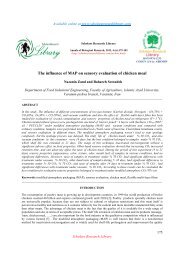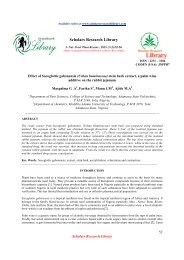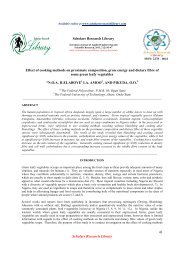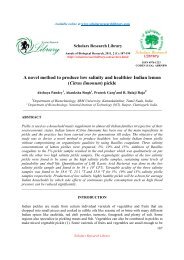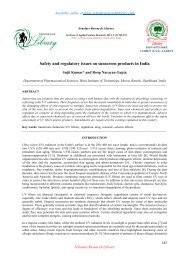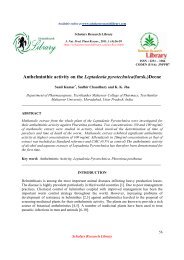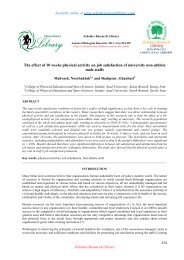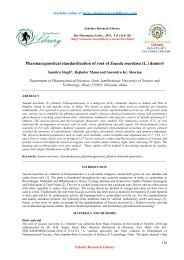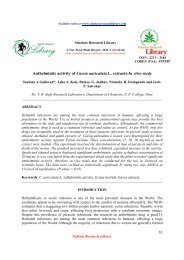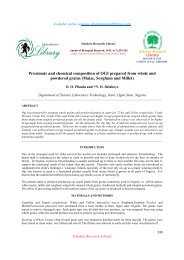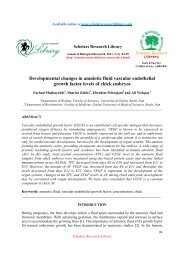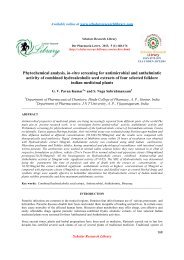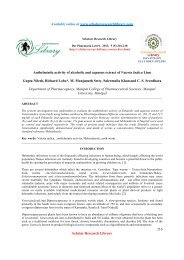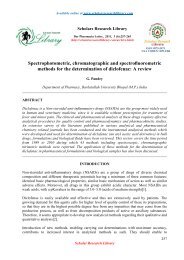Regulation for safety and quality of cosmetics vis - Scholars ...
Regulation for safety and quality of cosmetics vis - Scholars ...
Regulation for safety and quality of cosmetics vis - Scholars ...
Create successful ePaper yourself
Turn your PDF publications into a flip-book with our unique Google optimized e-Paper software.
Sujit Kumar et al Der Pharmacia Lettre, 2012, 4 (1):181-191<br />
_____________________________________________________________________________<br />
surma, hair colours, talcum etc. had showed alarming results. The issue was raised on the floor <strong>of</strong><br />
the parliament [20].<br />
Health Canada’s “Draft guidance on heavy metal impurities in <strong>cosmetics</strong>,(2009)” has<br />
acknowledged that heavy metal impurities in cosmetic products are unavoidable due to the<br />
ubiquitous nature <strong>of</strong> these elements, but should be removed wherever technically feasible. Heavy<br />
metal concentrations in cosmetic products are seen to be technically avoidable when they exceed<br />
these limits: Lead: 10 ppm; Arsenic: 3 ppm; Cadmium: 3 ppm; Mercury: 3 ppm; Antimony:<br />
5 ppm [21].<br />
Lead<br />
Lead affects almost every system in the body such as the reproductive, neurological,<br />
hematopoietic, hepatic <strong>and</strong> renal systems [22]. Pregnant women <strong>and</strong> young children are<br />
particularly vulnerable to lead exposure. Children absorb about 50% <strong>of</strong> ingested lead [23]. The<br />
use <strong>of</strong> lead contaminated lipstick or eye shadows by pregnant or/<strong>and</strong> lactating women could<br />
expose the foetus <strong>and</strong> infants to the risk <strong>of</strong> lead poisoning. Latest study shows that there is no<br />
safe level <strong>of</strong> lead exposure [24]. The Centre <strong>for</strong> Disease Control <strong>and</strong> Prevention (CDC) has even<br />
gone so far as to recommend that parents should avoid using <strong>cosmetics</strong> on their children as that<br />
could be contaminated with lead [25].<br />
The Drinking Water Guidelines in Canada limit the lead content to a Maximum Acceptable<br />
Concentration (MAC) <strong>of</strong> 0.010 milligrams per litre (0.010 ppm) <strong>of</strong> water [26]. Acceptable oral<br />
intake <strong>of</strong> lead impurities include 0.1 ppm (US FDA <strong>for</strong> c<strong>and</strong>y) to 10 ppm (USP <strong>for</strong> nutritional<br />
supplements). The World Health Organization (WHO) has established 25 micrograms <strong>of</strong> lead per<br />
kilogram <strong>of</strong> body weight per week as a pro<strong>vis</strong>ional tolerable weekly intake (PTWI) <strong>for</strong> children.<br />
Health Canada's Natural Health Products Directorate (NHPD) limits lead in products applied to<br />
the skin to 10 ppm (NHPD Compendium <strong>of</strong> Monographs).<br />
Arsenic<br />
Arsenic exerts adverse effects on the skin <strong>and</strong> keratinizing structures including the hair <strong>and</strong> nails.<br />
There<strong>for</strong>e, symptoms <strong>of</strong> acute overexposure include a variety <strong>of</strong> skin eruptions, alopecia <strong>and</strong><br />
characteristic striation <strong>of</strong> the nails [27]. Children could ingest arsenic-containing <strong>cosmetics</strong> from<br />
h<strong>and</strong>-to-mouth contact (e.g. by rubbing their h<strong>and</strong>s over the mouth <strong>and</strong>/or eating after rubbing<br />
the face). Arsenic <strong>and</strong> its inorganic compounds, <strong>and</strong> cadmium <strong>and</strong> its compounds are considered<br />
human carcinogens [28].<br />
The maximum acceptable concentration (MAC) <strong>for</strong> arsenic in drinking water is 0.010 mg/L<br />
(10 mcg/L = 10 ppb) in Canada [29]. Acceptable limits <strong>of</strong> oral ingestion <strong>of</strong> arsenic impurities<br />
include 0.1 ppm in foods (Health Canada) to 3 ppm in nutritional supplements (USP). The US<br />
FDA limit <strong>for</strong> arsenic in certain colourants is



